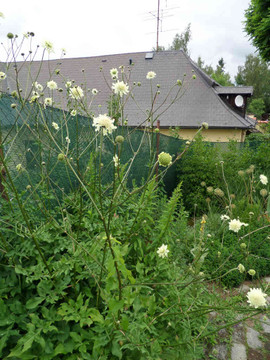
Angelica gigas - KOREAN ANGELICA
Structural (architectural) biennial or short-lived perennial. Bold leaves the first season, blooming the second year with deep purple globes. Often very dark stems.
Favored by famous garden designers.
Medicinal plant of Traditional Chinese Medicine (dried root and other part of the plant are used for heart, lung, liver and women’s health issues).
Stays in the garden by re-seeding.
Blooming Time: end of August/beginning of September to September/October
Size: 4-6' high x 1.5-2' wide
USDA Zones: 5 to 9
Culture: full sun, half shade, rich soils with some organic material is a must = add compost, decaying leaves, adaptable to pH, tolerates clay. It seems to be tolerant to heat and humidity
Moisture Needs: medium, medium-moist
Origin: forests, woodland edges, grassland, bank streams in Korea, China and Japan
Black Walnut Tolerant: possibly yes
Deer/Rabbit Resistant: yes/yes
Attracts Butterflies or Pollinators: pollinator magnet for various native bees, wasps and honey bees. Host plant for caterpillars of butterflies (like other carrot family plants)
Attracts Hummingbirds: no
Pot Size: square 3.5" x 4" deep perennial pot
Plant combination: Despite its height, it's better to plant it in the middle of the bed or even front - for better observation and enjoyment of its unusual beauty. Cottage gardens, naturalistic gardens, woodland edge gardens, pollinator gardens, herb gardens.
Best if combined with plants with smaller flowers to support the look good = Agastache, Phlox paniculata 'Jeanna', Verbena bonariensis, Thalictrum and fine-leaved taller grasses.
Other good companions can be Aruncus, taller hardy Geraniums, Hosta, tall and late blooming Hemerocallis cultivars, Hakonechloa, Heliopsis, Ligularia, Persicaria, other tall Phlox or any other common perennial that likes good loamy soil.
Picture copyright: Mark Dwyer, Landscape Prescriptions

Angelica gigas - KOREAN ANGELICA
Structural (architectural) biennial or short-lived perennial. Bold leaves the first season, blooming the second year with deep purple globes. Often very dark stems.
Favored by famous garden designers.
Medicinal plant of Traditional Chinese Medicine (dried root and other part of the plant are used for heart, lung, liver and women’s health issues).
Stays in the garden by re-seeding.
Blooming Time: end of August/beginning of September to September/October
Size: 4-6' high x 1.5-2' wide
USDA Zones: 5 to 9
Culture: full sun, half shade, rich soils with some organic material is a must = add compost, decaying leaves, adaptable to pH, tolerates clay. It seems to be tolerant to heat and humidity
Moisture Needs: medium, medium-moist
Origin: forests, woodland edges, grassland, bank streams in Korea, China and Japan
Black Walnut Tolerant: possibly yes
Deer/Rabbit Resistant: yes/yes
Attracts Butterflies or Pollinators: pollinator magnet for various native bees, wasps and honey bees. Host plant for caterpillars of butterflies (like other carrot family plants)
Attracts Hummingbirds: no
Pot Size: square 3.5" x 4" deep perennial pot
Plant combination: Despite its height, it's better to plant it in the middle of the bed or even front - for better observation and enjoyment of its unusual beauty. Cottage gardens, naturalistic gardens, woodland edge gardens, pollinator gardens, herb gardens.
Best if combined with plants with smaller flowers to support the look good = Agastache, Phlox paniculata 'Jeanna', Verbena bonariensis, Thalictrum and fine-leaved taller grasses.
Other good companions can be Aruncus, taller hardy Geraniums, Hosta, tall and late blooming Hemerocallis cultivars, Hakonechloa, Heliopsis, Ligularia, Persicaria, other tall Phlox or any other common perennial that likes good loamy soil.
Picture copyright: Mark Dwyer, Landscape Prescriptions






